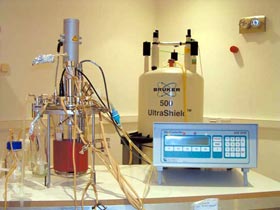| 2005 |

|
YEAR BOOK |
University College Dublin
|
Metabolic profiling using Nuclear Magnetic Resonance (NMR) spectroscopy
|
Dysregulations of metabolism are the basis of many diseases that cause large burdens on the health services in the western world. Type 2 diabetes is such a disease and development of new drugs to treat it is a major area of research. For successful treatment we must fully understand the metabolic disruptions and drugs must target certain areas of metabolism without affecting metabolism in other areas. Here in UCD we take a three-pronged approach to studying metabolism.
In the first case detailed metabolic studies are performed using labelled glucose and 13 C NMR to follow the metabolic fate of the glucose. All metabolites containing 13 C label, which originated from the labelled glucose, will give peaks in the spectra. Detailed analyses of the spectra yield important information about fluxes through certain key pathways under various conditions such as pre and post treatment of cells with drugs.

The final approach uses 1 H NMR to analyse all metabolites and is known as metabonomics or metabolomics. In this case 1 H NMR spectra of cells treated under various conditions are used together with multivariate data analysis to identify changes in metabolic processes. The major advantage of such an approach is that all metabolites are monitored thus avoiding pre-selection of various metabolic pathways. Additionally this approach allows us to link cell based metabolic changes with changes in vivo in humans. 1 H NMR spectra of biofluids (urine and plasma) from diabetics and control patients are currently allowing us to further understand the disruptions in metabolism and identify novel biomarkers of disease.
Contact: Dr Lorraine Brennan, Department of Biochemistry,
Conway Institute of Biomolecular and Biomedical Research,
UCD, Belfield, Dublin 4;
E-mail: [email protected]